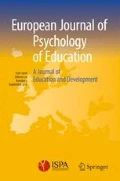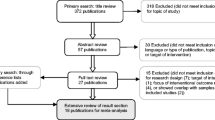Abstract
Two sets of quality measures of group care were used to assess their predictive power for two sets of measures of the development of infant and toddlers in group day care. One of the quality measures we investigated was the Early Childhood Environment Rating Scale (ECERS). We replicated the findings of Scarr, Eisenberg, & Dealer-Deckard (1994) which were that the total score of the ECERS represents a global index and that the 37 items making up the scale are redundant and could be shortened considerably without loss of the scale as a quality criterion of group care for young children. Neither Scarr, Eisenberg, and Dealer-Deckard (1994) nor our own Factor Analyses of the 37 items supported the a priori distinction of seven Subscales. However further findings indicate that regardless of the redundancy within ECERS, two Subscales, dealing mainly with adult-child, child-child and adult-adult interactions, predict the development of infants and toddlers, but only when the measures of development were based on participant observations of the children over a longer period of time and in the broad context of the natural daycare environment. None of the Subscales, nor the total ECERS predicted social development when it was based on precise time sampling observations, assessed by non participant observers, in interactions between a child and a specific caregiver. Such measures of development were well predicted in our study by caregiver behaviors assessed through Time Sampling Observations.
Résumé
On a utilisé deux ensembles de mesures de la qualité de la prise en charge pour estimer leur pouvoir prédictif de deux types d’évaluation du développement des jeunes enfants et nourrissons. L’un des ensembles de mesure a été effectué avec la “Early chilhood Environment Rating Scale (ECERS). On a fait les mêmes constats que Scarr, Eisenberg, et Dealer-Deckard (1994), à savoir que le score total à la ECERS constitue un indicateur global et que les 37 items de l’échelle sont homogènes. L’échelle ECERS peut être considérablement raccourcie sans préjudice de qualité pour ce qu’elle measure. Ni l’analyse factorielle de Scarr et al., ni notre propre analyse factorielle des 37 items ne justifient la distinction a priori entre les 7 sous échelles. Cependant, certains de nos résultats montrent que, indépendamment des redondances intra-échelle (ECERS), deux sous-échelles (concernant principalement les interactions adulte-enfant, enfant-enfant et adulte-adulte) prédisent le développment des jeunes enfants et nourrissons; mais ceci n’apparâit que si les mesures de développement sont fondées sur l’observation participante des enfants pendant une longue période de temps et dans le contexte large de l’environnement naturel de la prise en charge. Aucune des sous-échelles, pas plus que le score global, ne prédit le développement social quand il est fondé sur des échantillons temporels précis d’observation (avec des observateurs non participants) des interactions entre un enfant et un adulte chargé de s’en occuper. Par contre, de telles mesures de développement ont été bien prédites, dans notre étude, par les comportement des adultes s’occupant des enfants.
Similar content being viewed by others
References
Beller, E.K. (1983). The Philadelphia Study: The impact of preschool on intellectual and socio-emotional development. In E.K. Beller, R.B. Darlington, et al. (Eds.),As the twig is bent Consortium for Longitudinal Studies (pp. 333–376). Hillsdale, NJ: Lawrence Erlbaum.
Beller, E.K. (1995). Le tavola di sviluppo di Kuno Beller. Bergamo, Italia: Edizioni Junior.
Beller, E.K., Kuckartz, U. (1983). Beobachtungsdimensionen von Erzieherverhalten in Krippen. In K. Ingenkamp (Eds.),Kongreßbericht der Arbeitsgruppe ‘Empirische Pädagogik’ (pp. 277–290). Landau.
Beller, E.K., Stahnke, M, & Laewen, H.J. (1983). Das Berliner Krippenprojekt — ein empirischer Bericht.Zeitschrift für Pädagogik, 29, 407–416.
Belsky, J., Steinberg, L.D., & Walker, A. (1982). The ecology of day care. In M.E. Lamb (Ed.),Nontraditional Families (pp. 71–116). Hillsdale, NJ: Erlbaum.
Clarke-Stewart, K.A. (1987a). Does day care affect development?Journal of Reproductive and Infant Psychology, 9, 67–79.
Clarke-Stewart, K.A. (1987b). In search of consistencies in child care research. In D.A. Phillips (Ed.),Quality in Child Care: What Does Research Tell Us? (pp. 21–41). Washington, DC: National Association for the Education of Young Children.
Clarke-Stewart, K.A., & Fein, G. (1983). Early Childhood Programs. In M.M. Haith & J.J. Campos (Eds.),Handbook of Child Psychology: Infancy and development psychobiology (Vol. 2, pp. 917–1000). New York: Wiley.
Golden, M., Rosenbluth, L., Grossi, M.T., Policare, H.J., Freeman, H., Jr., & Brownlee, E.M. (1978).The New York City Infant Day Care Study. New York: Medical and Health Research Association of New York City.
Harms, T., & Clifford, R. (1980).Early Childhood Environmental Rating Scale. New York: Teachers College, Columbia University.
Howes, C. (1983). Caregiver behavior in center and family day care.Journal of Applied Developmental Psychology, 4, 99–107.
Howes, C., Phillips, D.A., & Whitebook, M. (1992). Thresholds of quality: Implication for the social development of children in center-based child care.Child Development, 63, 449–460.
Katz, L. (1994).Perspectives on the quality of early childhood programms. Presented at the Symposium ‘Neue Entwicklungen in der Kleinkindpädagogik’, Berlin: Freie Universität.
Lamb, M., Hwang, P., Bookstein, F.L., Broberg, A., Hult, G., & Frodi, M. (1988). Determinants of social competence in Swedish preschoolers.Developmental Psychology, 24, 58–70.
McCartney, K. (1984). The effect of quality of day care environment upon children’s language development.Developmental Psychology, 20, 244–260.
McCartney, K., Scarr, S., Phillips, D., Grajek, S. (1985). Day care as intervention: Comparisons of varying quality programs.Journal of Applied Developmental Psychology, 6, 247–260.
Moss, P. (1995). Defining objectives in early childhood services. Presented at the 5th European Conference on the Early Childhood Education, Paris, France.
Phillips, D.A., McCartney, K., & Scarr, S. (1987). Child care quality and childrens’s social development.Developmental Psychology, 23, 537–543.
Ruopp, R., Travers, J., Glantz, F., & Coelen, C. (1979).Children at the Centre. Cambridge, MA: ABT Associates.
Rutter, M. (1981). Socio-emotional consequences of daycare for preschool children.American Psychologist, 5, 4–28.
Scarr, S., Eisenberg, M., & Dealer-Deckard, K. (1994). Measurement of quality in child care centers.Early Childhood Research Quarterly, 9, 131–151.
Author information
Authors and Affiliations
Rights and permissions
About this article
Cite this article
Beller, E.K., Stahnke, M., Butz, P. et al. Two measures of the quality of group care for infants and toddlers. Eur J Psychol Educ 11, 151–167 (1996). https://doi.org/10.1007/BF03172721
Received:
Issue Date:
DOI: https://doi.org/10.1007/BF03172721




